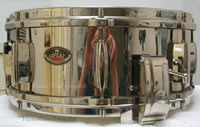In
the mid-fifties the Dutch government decides to carry
out a set of very firm economical measures to help
the Dutch economy to rise again. Wages are ‘frozen’
and the purchasing power of the Dutch people is very
low. By this the sale of the Triumph snares -a luxury
good- stagnates. The storehouses of Van Wouw are loaded
with snare drums and he doesn’t manage to sell
one instrument. He terminates the production of the
snares and a big problem looms up for Looise and Vogel.
They are forced to dismiss all their fellow workers.
And now? What to do? A daring plan comes into the
mind of both men. What if they develop an even more
beautiful, but less expensive snare drum, affordable
to a lot of people? Looise and Vogel make contact
with eight musical instrument shops all over the country.
The eight shops are well known with the quality of
the old Triumph’s and give the project a ‘go’:
Looise and Vogel start with their own new drum brand:
‘Royal’.
The
new Royal snare has to be ‘one of a kind’
off course. It shouldn’t be even a little bit
similar to the old Triumph snare. A fully new design
is necessary. Therefore the snare mechanism is changed
and lugs and hoops are new shaped. What remains is
the almost fully handcrafted production of the instrument
- 90% of the snare drum is ‘made in the house’
and the quality: unaltered high. Only the calf skin
heads are imported from Ireland.
|
 |
When
the economy, in the end of the fifties is rising again,
Mr. van Wouw returns in the Bloemstraat and the second
generation Triumph’s is a fact. Between 1957
and 1962 both brands are made but it is mainly Royal
that is being sold to shops, marching bands and private
(jazz-)drummers. In the year 1962 Van Wouw decides
to cease production and again concentrates entirely
on the import of Spanish guitars. The next years many
drummers and percussionists find their way to the
Bloemstraat in the Jordaan. They buy snaredrums but
also complete drum kits, build to their own specifications.
Everything was possible: different sizes, different
colours, different wraps, different hardware, you
name it. Nothing was weird or funny, if Looise and
Vogel were able to manage it, they did so. Therefore
they made –and invented- some special stuff,
for instance a complete foldable jazz kit for jazz
drummer Clarence Becton, because Clarence wanted to
transport his drum kit to a gig by bike! He didn’t
want to use a car in the busy and crowded inner city
of Amsterdam.
Famous
Dutch drummers did have a coffee in the Bloemstraat,
for instance Mr. John Engels, who played with almost
every American jazz musician. And when John came to
the firm about lunchtime -very often he planned so-
he knew there was always something nice and fresh
to eat and drink. Join the way of life of Looise and
Vogel, join their quality in everything, including
their lunches! And every Friday afternoon at 16.00
hours they both sat in their basement, counted their
receipts and expenditure, while drinking a nice schnapps
or gin. |
